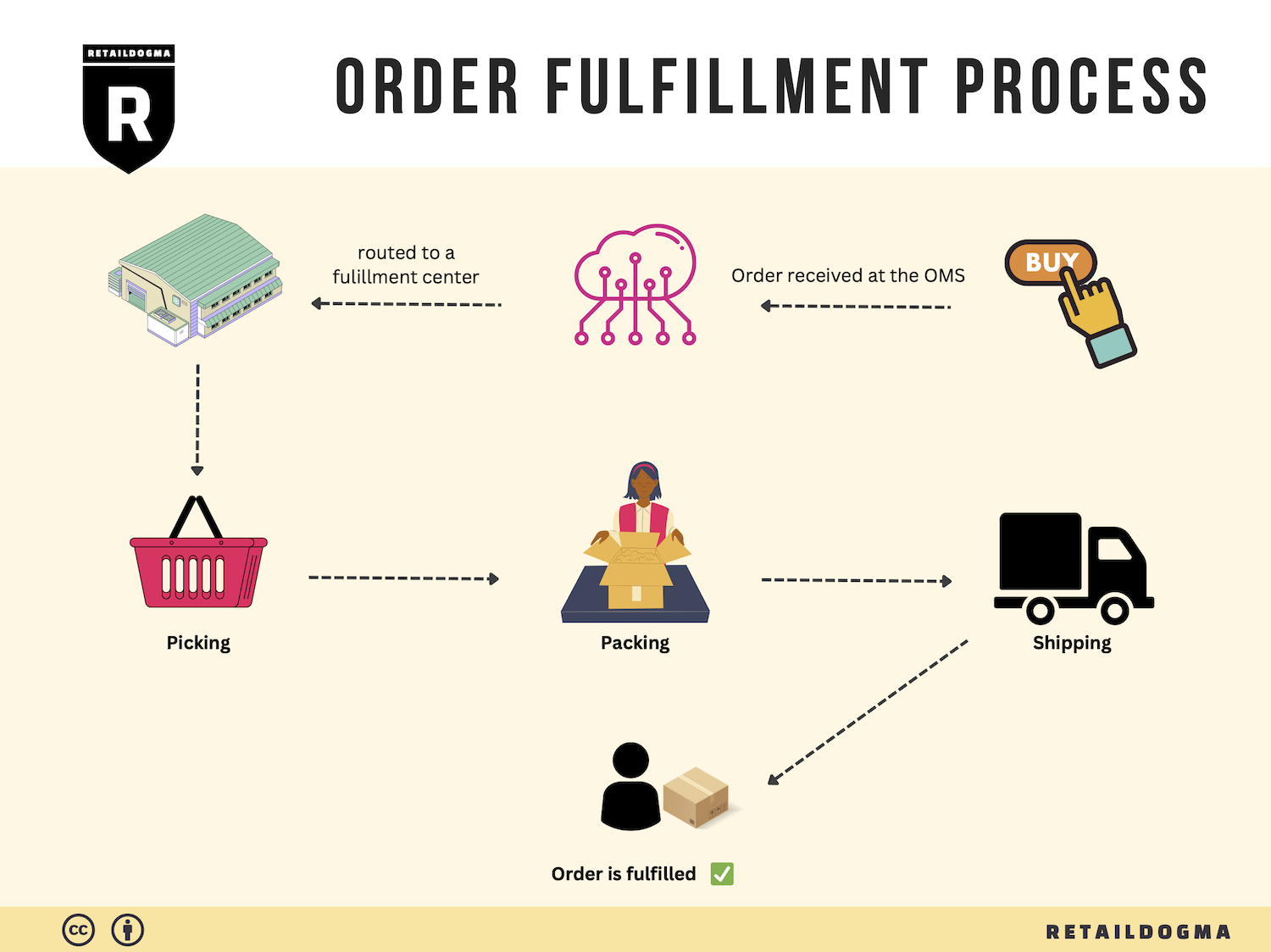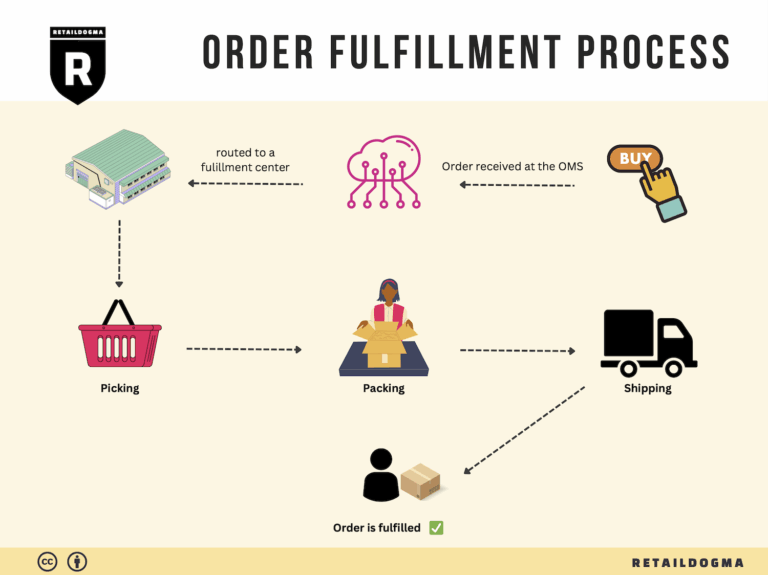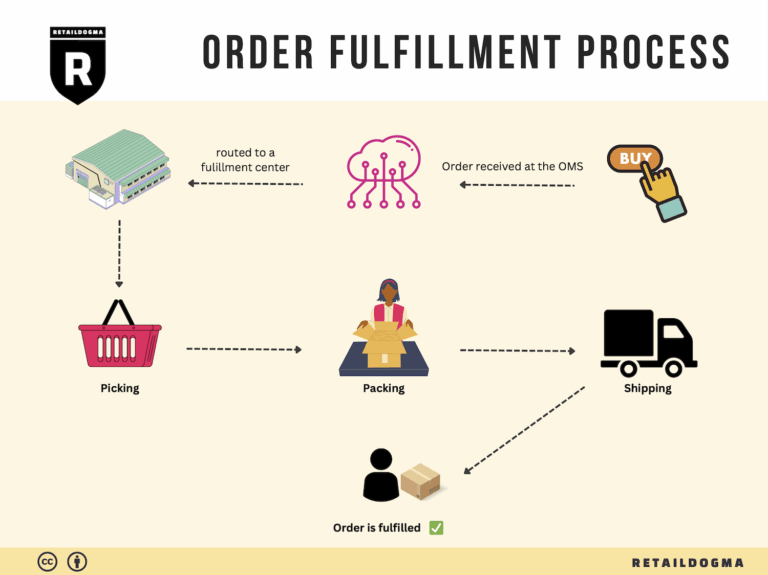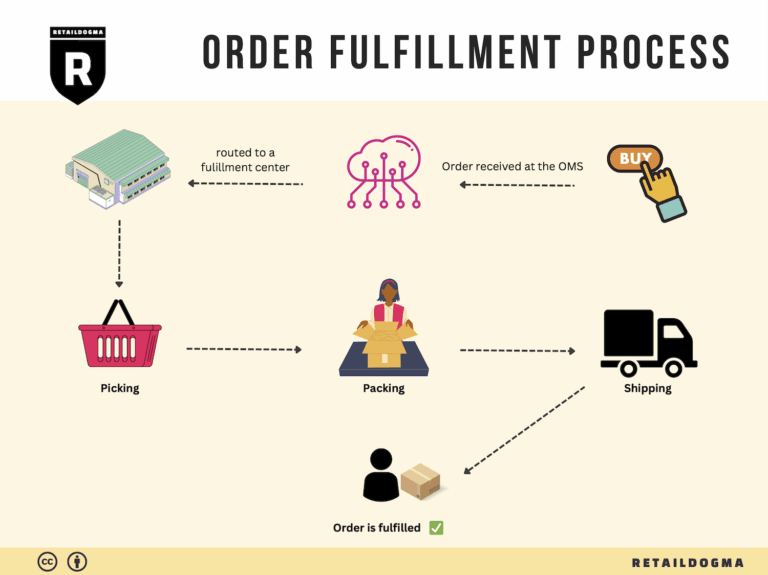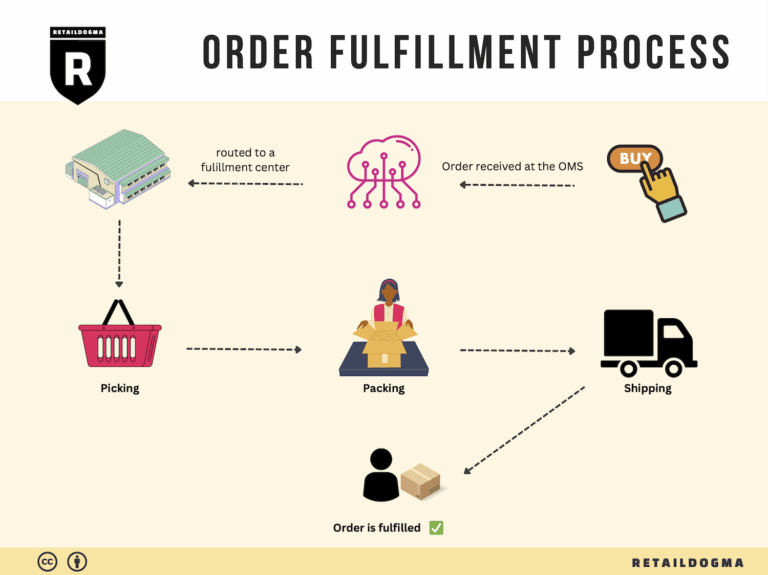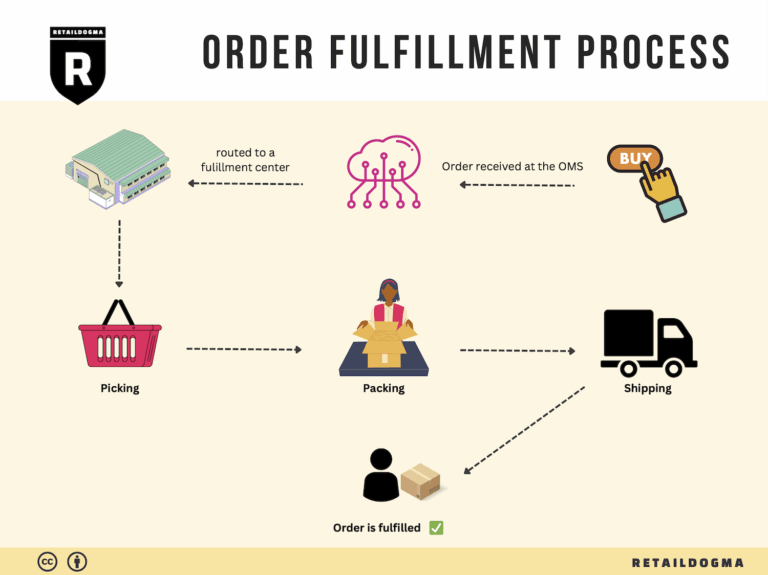How Order Fulfillment Works: A Step-by-Step Guide for Businesses
What is E-commerce Fulfillment? An Introduction for Growing Businesses
Understanding E-commerce Fulfillment
For many growing online businesses, the excitement of increased sales can quickly turn into overwhelm when it comes to packing and shipping orders. Managing logistics—especially as your order volume rises—can become a significant challenge. This is where e-commerce fulfillment comes into play. At its core, fulfillment is the process of getting a product from your warehouse or storage facility to the customer’s doorstep. It encompasses everything from receiving inventory and storing products to picking, packing, and shipping orders.
In this guide, we will delve into the various models of e-commerce fulfillment that can help streamline your operations and enhance customer satisfaction. We’ll explore options such as Third-Party Logistics (3PL) and Fulfillment by Amazon (FBA), each offering unique advantages for businesses looking to scale. Understanding these models is crucial for making informed decisions about your logistics strategy.
Core Services of E-commerce Fulfillment
We will also outline the essential services that a fulfillment partner should provide, including inventory management, order processing, and returns handling. These services not only ensure that your products reach customers efficiently but also help you maintain a positive brand reputation in a competitive marketplace.
Choosing the Right Partner
Selecting the right fulfillment partner can significantly impact your business’s success. We will discuss key factors to consider when evaluating potential partners, such as their technology capabilities, location, scalability, and customer support. This section will empower you to ask the right questions and make choices that align with your business goals.
Understanding Pricing Structures
Finally, we’ll break down the various pricing models associated with fulfillment services. From per-order fees to storage costs and shipping rates, understanding these elements will help you budget effectively and avoid unexpected expenses.
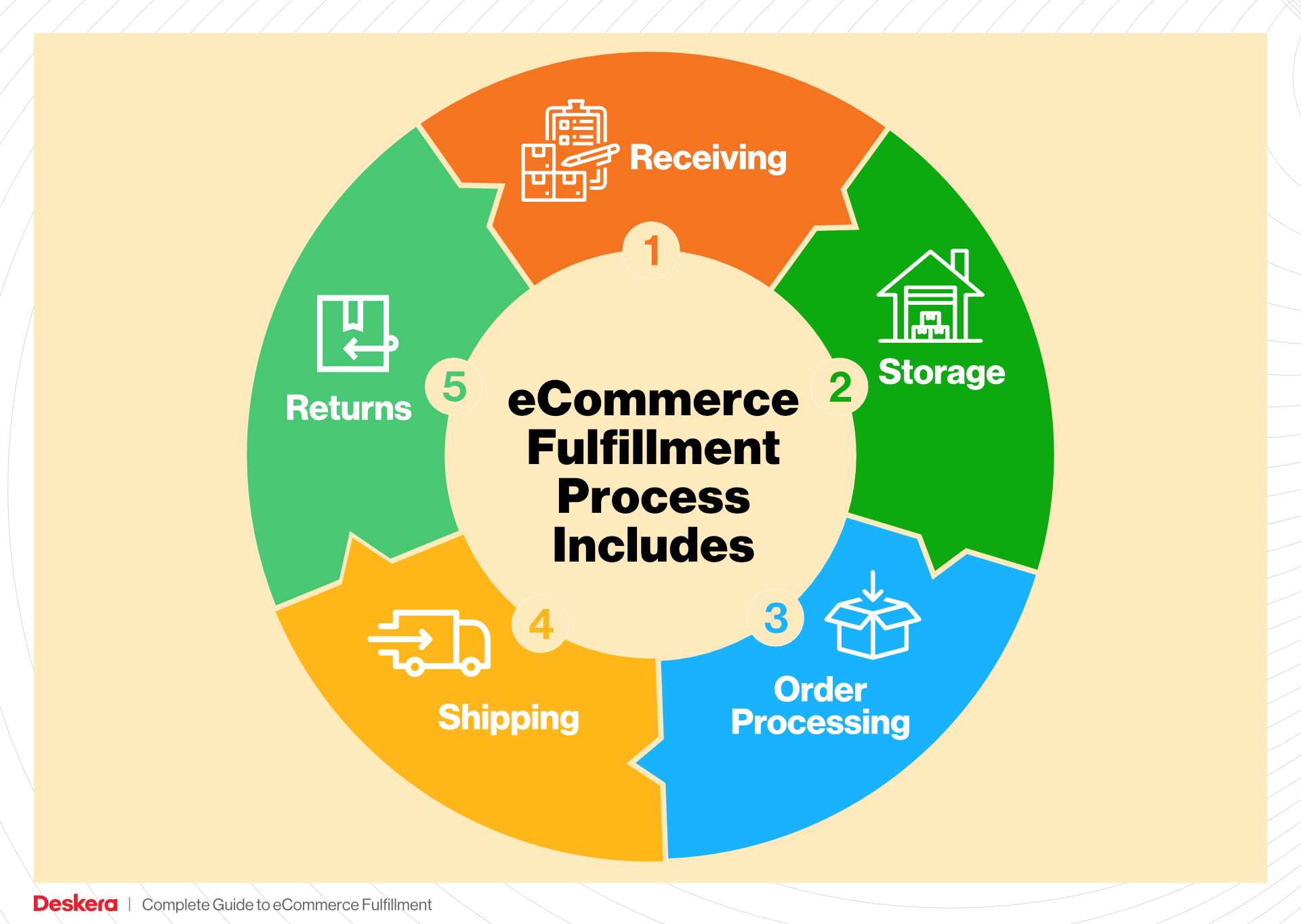
Empowering Your Business
The goal of this guide is to equip you with the knowledge needed to make strategic decisions about your logistics and fulfillment processes. By understanding the intricacies of e-commerce fulfillment, you can optimize your operations, enhance customer satisfaction, and ultimately drive your business growth. Whether you are just starting out or looking to scale, this guide will provide you with practical insights to navigate the complexities of e-commerce fulfillment confidently.
What You’ll Learn In This Guide
- What is E-commerce Fulfillment? An Introduction for Growing Businesses
- The Order Fulfillment Process: From ‘Buy’ Button to Customer’s Door
- Comparing Fulfillment Models: In-House vs. 3PL vs. Dropshipping
- A Deep Dive into Amazon FBA: Pros, Cons, and Who It’s For
- Core Services Offered by Fulfillment Centers
- How to Choose a Fulfillment Partner: A 6-Point Checklist
- Understanding Fulfillment Pricing: A Breakdown of Common Fees
- Frequently Asked Questions (FAQs) about Fulfillment
- Conclusion: Is Outsourcing Fulfillment the Right Move for Your Business?
- Important Disclaimer
The Order Fulfillment Process: From ‘Buy’ Button to Customer’s Door
1. Receiving Inventory
The first step in the order fulfillment process is receiving inventory. This involves the arrival of goods at the fulfillment center, where they are unloaded, inspected, and logged into the inventory management system. Each item is assigned a unique identifier, typically a Stock Keeping Unit (SKU), which helps track the product throughout the entire fulfillment process.
Receiving inventory is crucial because it ensures that the fulfillment center has the necessary stock to fulfill customer orders. Accurate inventory management at this stage prevents stockouts or overstock situations, which can lead to lost sales or increased holding costs. Efficient receiving processes can also reduce the time it takes for products to be available for sale, directly impacting customer satisfaction.
Key Term: SKU (Stock Keeping Unit) – A unique identifier for each product that facilitates tracking and inventory management.
2. Warehouse Storage
Once inventory is received and logged, the next step is warehouse storage. Products are organized and stored in designated locations within the fulfillment center, often utilizing a systematic approach such as zone storage or bin storage. This organization allows for easy retrieval of items when orders are placed.
Warehouse storage is important because it maximizes space utilization and minimizes the time required to locate products. A well-organized warehouse can significantly improve operational efficiency, reducing the time and labor costs associated with order fulfillment. Additionally, using advanced inventory management systems can provide real-time visibility into stock levels, enabling proactive restocking and better inventory forecasting.
Key Term: Bin Location – The specific spot within a warehouse where an item is stored, which aids in efficient order picking.
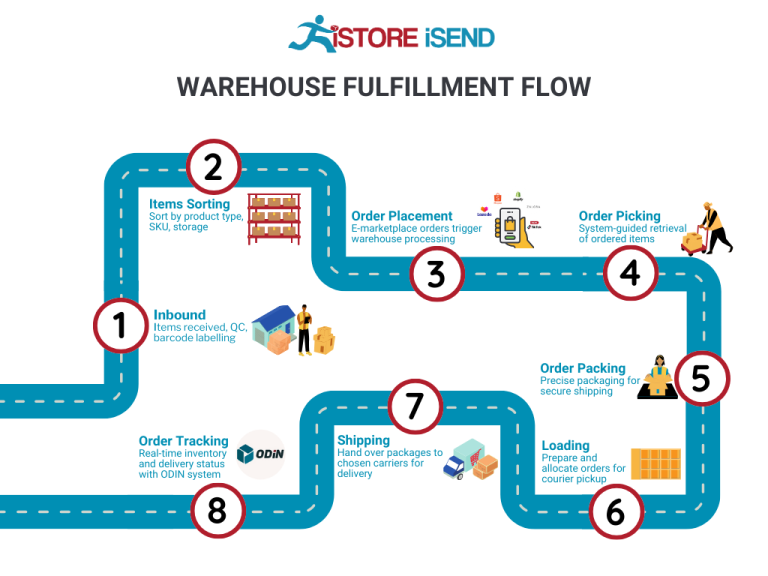
3. Order Picking
Order picking is the process of selecting items from the warehouse to fulfill a customer order. When an order is placed, a pick list is generated, detailing the items and their locations within the warehouse. Warehouse staff or automated systems then retrieve these items based on the pick list.
This step is critical because it directly affects order accuracy and fulfillment speed. Efficient order picking processes can lead to quicker turnaround times, enhancing customer satisfaction. Various picking methods, such as single order picking, batch picking, or wave picking, can be employed depending on the volume and nature of orders, helping businesses optimize their workflows.
Key Term: Pick List – A document or digital file that outlines the items to be retrieved for fulfilling an order, including their bin locations.
4. Order Packing
After items are picked, they move to the packing stage, where they are prepared for shipment. This involves checking the items against the order details, packing them securely into boxes, and labeling them for delivery. Packaging materials are selected based on the type and size of the items to ensure they arrive safely at the customer’s door.
Order packing is significant as it protects the products during transit and ensures that the correct items are sent to customers. Efficient packing processes can reduce shipping costs and minimize returns due to damage or incorrect items. Moreover, incorporating branded packaging can enhance the customer’s unboxing experience, adding value to the overall service.
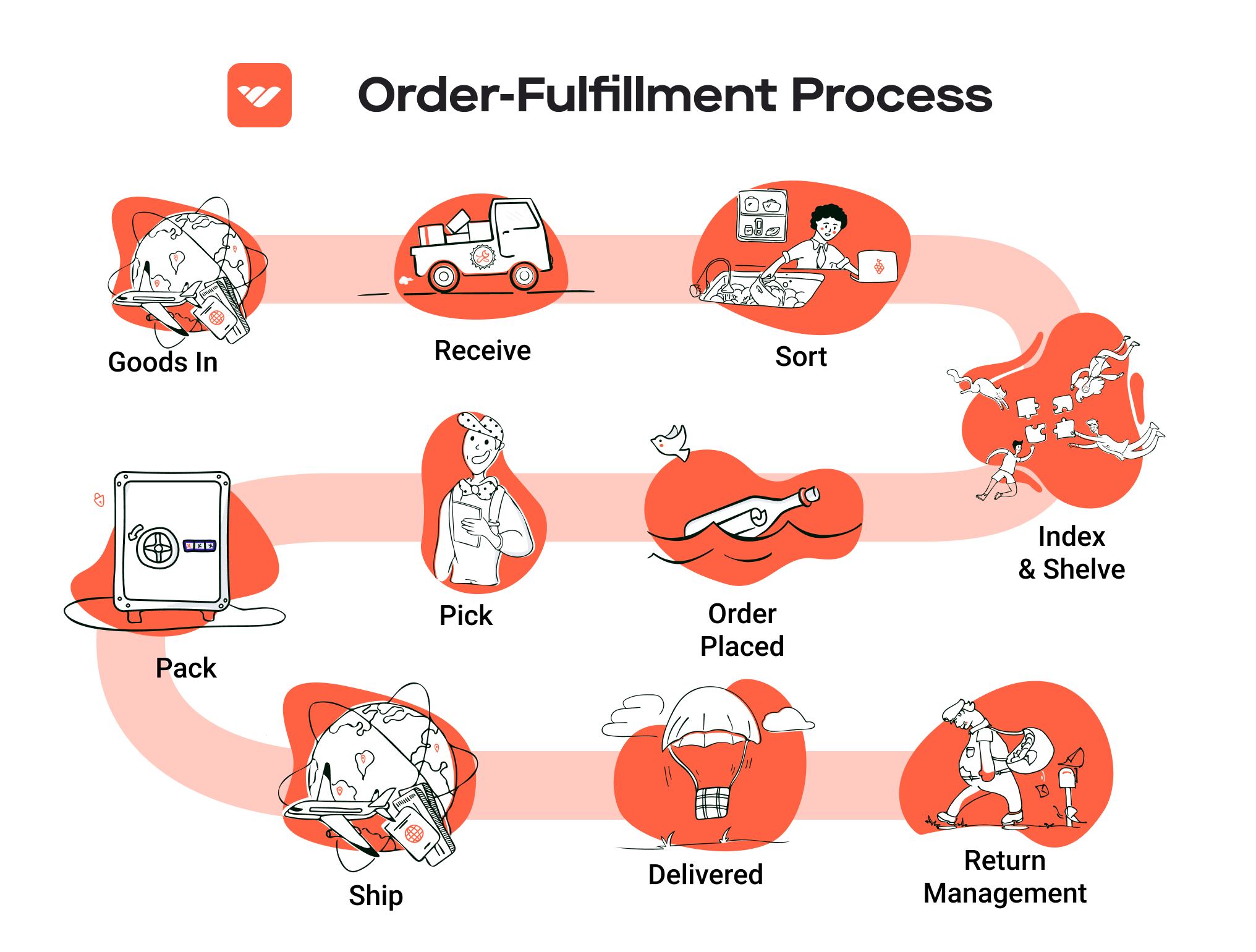
Key Term: Packing Slip – A document included with the shipment that lists the items in the package, serving as a confirmation of the order contents.
5. Shipping & Delivery
The final step in the order fulfillment process is shipping and delivery. Once orders are packed, they are handed over to shipping carriers for distribution to the customer. Fulfillment centers often have partnerships with multiple carriers to offer various shipping options, such as standard, expedited, or same-day delivery.
Shipping and delivery are vital components of the fulfillment process because they determine how quickly and reliably customers receive their orders. Timely delivery can significantly enhance customer satisfaction and loyalty. Moreover, tracking systems allow both businesses and customers to monitor the shipment’s progress, adding transparency to the process.
Key Term: Last-Mile Delivery – The final step in the shipping process, where the package is delivered from a distribution center to the end customer, often considered the most critical phase in ensuring customer satisfaction.
By understanding and optimizing each step of the order fulfillment process, e-commerce businesses can enhance operational efficiency, improve customer satisfaction, and ultimately scale their logistics operations effectively.
Comparing Fulfillment Models: In-House vs. 3PL vs. Dropshipping
Fulfillment Models Overview
When it comes to scaling an e-commerce business, selecting the right fulfillment model is critical. Each model offers unique benefits and challenges that can significantly impact your operations, customer satisfaction, and overall profitability. Below is a comparative analysis of three prominent fulfillment models: In-House Fulfillment, Third-Party Logistics (3PL), and Dropshipping.
| Model | Who Handles Inventory | Best For (Business Stage) | Key Advantage | Key Disadvantage |
|---|---|---|---|---|
| In-House Fulfillment | The business itself | Startups to established businesses | Greater control over inventory | High overhead costs |
| Third-Party Logistics (3PL) | A third-party logistics provider | Growing businesses | Scalability and expertise | Less control over inventory |
| Dropshipping | Supplier or manufacturer | New businesses or those with limited capital | Low upfront investment | Lower profit margins |
In-House Fulfillment
In-house fulfillment refers to managing the entire inventory and order fulfillment process within your own facilities. This model is suitable for startups and established businesses that have the resources to maintain a warehouse and handle logistics independently. The key advantage of in-house fulfillment is the greater control it provides over inventory management, quality assurance, and customer service. Businesses can customize their fulfillment processes to align closely with their brand and customer expectations.
However, this model comes with significant disadvantages. Operating your own fulfillment center requires substantial upfront investment in infrastructure, technology, and staffing. Additionally, the ongoing costs associated with warehousing, utilities, and labor can be high. As your business scales, these costs can become burdensome, especially if demand fluctuates. In-house fulfillment can also limit your ability to scale quickly, as expanding warehouse space and workforce can be a lengthy and complex process.
Third-Party Logistics (3PL)
Third-party logistics (3PL) providers handle inventory management, warehousing, and shipping on behalf of businesses. This model is ideal for growing businesses that want to scale quickly without the burden of managing logistics themselves. By outsourcing fulfillment to a 3PL, companies can leverage the provider’s expertise, technology, and established networks to improve efficiency and reduce costs.
One of the main advantages of using a 3PL is scalability. As your business grows, a 3PL can easily adjust to increased order volumes, seasonal fluctuations, and geographic expansion. Additionally, 3PLs often have advanced logistics technologies that enhance supply chain visibility and streamline operations. However, the trade-off is less control over inventory and fulfillment processes, which can lead to discrepancies in quality and service. Choosing the right 3PL partner is crucial, as inadequate service can negatively impact customer satisfaction and brand reputation.
Dropshipping
Dropshipping is a fulfillment model where the retailer does not hold any inventory but instead relies on suppliers to ship products directly to customers. This model is particularly appealing for new businesses or those with limited capital, as it requires minimal upfront investment. Retailers can offer a wide range of products without the financial risk associated with purchasing inventory upfront.
The key advantage of dropshipping is the low operational overhead. Businesses can focus on marketing and customer acquisition without worrying about warehousing or fulfillment logistics. Additionally, dropshipping allows for flexibility in product offerings and easier market testing. However, the model comes with significant drawbacks, including lower profit margins, as suppliers typically charge higher prices for dropshipped goods. Furthermore, reliance on suppliers can lead to delays in shipping and issues with product quality, which can negatively affect customer satisfaction. Building strong relationships with reliable suppliers is essential for mitigating these risks.
Conclusion
Choosing the right fulfillment model is a pivotal decision for e-commerce businesses aiming to scale. In-house fulfillment offers control and customization but at a high cost. Third-party logistics provide scalability and expertise but may compromise control. Dropshipping presents a low-risk entry point but can limit profitability and reliability. Each model has its own set of advantages and disadvantages, and the best choice depends on your business’s specific needs, growth stage, and operational capabilities. As you navigate these options, consider how each model aligns with your long-term business goals and customer expectations.
A Deep Dive into Amazon FBA: Pros, Cons, and Who It’s For
Understanding Fulfillment by Amazon (FBA)
Fulfillment by Amazon (FBA) is a service provided by Amazon that allows e-commerce sellers to store their products in Amazon’s fulfillment centers. Amazon then takes care of storage, packaging, and shipping of these products directly to the customers. This service also handles customer service and returns, enabling sellers to focus on other aspects of their business.
The FBA process begins when a seller creates an Amazon seller account and lists their products on the Amazon marketplace. Sellers send their inventory to Amazon’s fulfillment centers, such as the CMH2 center located in Groveport, Ohio. When a customer places an order for a product, Amazon picks, packs, and ships the product on behalf of the seller. Customers enjoy the benefits of fast shipping options, including same-day and two-day delivery through Amazon Prime.
How FBA Works
-
Product Listing and Inventory Sending: Sellers create listings for their products on Amazon. Once the listings are live, sellers prepare their products and ship them to an Amazon fulfillment center.
-
Storage and Management: Once the products arrive at the fulfillment center, Amazon takes care of storage. The products are stored in a highly organized warehouse, which allows for efficient picking and packing.
-
Order Fulfillment: When a customer orders a product, Amazon’s system automatically processes the order. Warehouse staff pick the product from storage, pack it, and ship it to the customer.
-
Customer Service: Amazon also manages customer service inquiries related to FBA orders, including handling returns and refunds.
-
Reporting and Analytics: Sellers can access detailed reports and analytics on their sales, inventory levels, and customer feedback through their Amazon seller account.
Pros of Using FBA
1. Prime Eligibility
One of the most significant advantages of FBA is that it makes your products eligible for Amazon Prime. Prime members enjoy free two-day shipping, which can significantly increase conversion rates. Being part of the Prime program also enhances visibility and credibility, as customers are more likely to purchase items that are Prime-eligible.
2. Customer Trust and Credibility
Amazon’s reputation as a reliable and customer-centric platform is a huge benefit for sellers using FBA. Customers are more likely to trust and buy from sellers who use FBA because they know they will receive their orders quickly and efficiently. This trust can lead to higher sales and customer loyalty.
3. Multi-Channel Fulfillment
FBA allows sellers to fulfill orders not just from Amazon, but also from other sales channels. Whether you sell on your own website or through other online marketplaces, you can use Amazon’s fulfillment network to ship orders. This streamlines operations and helps manage inventory more effectively.
4. Simplified Logistics
FBA takes the burden of logistics off the seller’s shoulders. Amazon handles storage, packing, and shipping, allowing sellers to focus on product development, marketing, and customer engagement. This can be particularly advantageous for small businesses or those just starting out.
Cons of Using FBA
1. High Fees
While FBA provides significant benefits, it also comes with associated costs. Amazon charges sellers for storage space and fulfillment fees, which can add up quickly, especially for those with a large inventory or lower-priced items. Sellers need to carefully calculate their margins to ensure profitability.
2. Strict Inventory Rules
Amazon has strict policies regarding inventory management and storage. Sellers must adhere to guidelines on inventory limits, and failure to comply can result in penalties or additional fees. This can be particularly challenging for sellers with fluctuating inventory levels.
3. Commingling Risks
FBA uses a practice called commingling, where products from different sellers are stored together in the same inventory. While this can improve shipping efficiency, it poses a risk for sellers. If a customer receives a defective item or a return is processed incorrectly, it can be difficult to trace the origin of the problem, potentially harming the seller’s reputation.
4. Dependency on Amazon
Using FBA can create a dependency on Amazon’s platform. Sellers must adhere to Amazon’s policies and are subject to their rules and changes, which can affect their business. Additionally, any issues with Amazon’s system can impact the seller’s ability to fulfill orders and maintain customer satisfaction.
Who is FBA Best For?
Fulfillment by Amazon is best suited for sellers looking to scale their e-commerce business without the burden of handling logistics and customer service. Here are some specific groups that may find FBA particularly beneficial:
-
Small and Medium-Sized Enterprises (SMEs): Businesses that may not have the resources to manage warehousing and shipping can leverage FBA to streamline operations.
-
Startups: New sellers looking to establish themselves in the competitive e-commerce space can benefit from Amazon’s vast customer base and trusted fulfillment services.
-
Sellers with High Sales Volumes: Those who have a consistent sales volume can take advantage of the efficiencies offered by FBA and potentially lower shipping costs due to volume.
-
Multi-Channel Sellers: Businesses that sell on various platforms can use FBA to manage their logistics, allowing them to focus on marketing and sales across different channels.
In conclusion, while Fulfillment by Amazon presents both opportunities and challenges, it remains a powerful tool for e-commerce sellers aiming to enhance their operational efficiency and customer satisfaction. Understanding both the pros and cons will enable business owners to make informed decisions about whether FBA aligns with their long-term growth strategies.
Core Services Offered by Fulfillment Centers
Inventory Management & Warehousing
Inventory management and warehousing are foundational services provided by fulfillment centers. This process encompasses the systematic control of stock levels, storage, and organization of products within a warehouse. Fulfillment centers utilize advanced inventory management systems that track inventory in real time, allowing businesses to maintain optimal stock levels, reduce excess inventory, and avoid stockouts.
Benefits:
-
Enhanced Visibility: E-commerce businesses gain real-time insights into their inventory status, which aids in making informed purchasing decisions and forecasting demand accurately.
-
Cost Efficiency: By optimizing inventory levels, businesses can minimize holding costs associated with excess stock and reduce the risk of obsolescence.
-
Space Optimization: Fulfillment centers are designed to maximize storage efficiency, utilizing vertical space and advanced shelving systems to accommodate various product sizes and types, thereby reducing overall warehousing costs.
-
Scalability: As your business grows, fulfillment centers can easily scale operations to accommodate increased inventory needs without the burden of investing in additional warehouse space or staff.
Pick and Pack Services
Pick and pack services are integral to the order fulfillment process. This service involves selecting items from inventory (picking) and packaging them for shipment (packing) based on customer orders. Fulfillment centers employ efficient picking methods—such as batch picking, wave picking, or zone picking—to streamline the process, ensuring orders are fulfilled quickly and accurately.
Benefits:
-
Speed and Efficiency: Fulfillment centers leverage technology and experienced staff to expedite the picking and packing process, which is critical in meeting customer expectations for fast delivery.
-
Accuracy: Advanced systems, such as barcode scanning and automated packing solutions, significantly reduce the chances of human error, ensuring customers receive the correct products.
-
Customized Packaging: Many fulfillment centers offer tailored packaging solutions that enhance brand presentation and protect products during transit, thus improving customer satisfaction.
-
Order Scalability: As sales volumes fluctuate, fulfillment centers can easily adjust their picking and packing operations to handle varying order sizes, ensuring your business can respond swiftly to market demands.
Kitting and Assembly
Kitting and assembly services involve combining multiple individual items into a single packaged unit or preparing products for sale. This can include assembling products, creating gift sets, or bundling items together to enhance value for customers. Fulfillment centers provide the necessary labor and equipment to perform these tasks efficiently.
Benefits:
-
Value Addition: By offering kitted products, businesses can create unique offerings that differentiate them in a competitive marketplace, potentially increasing average order value.
-
Streamlined Operations: Outsourcing kitting and assembly to fulfillment centers allows e-commerce businesses to focus on core activities such as marketing and product development while reducing the complexity of in-house assembly processes.
-
Inventory Management: Kitting can also help in managing inventory more effectively, as it consolidates various components into a single SKU, simplifying tracking and reducing the number of individual items to monitor.
-
Flexibility: Fulfillment centers can adapt to seasonal demands or promotional campaigns by quickly adjusting kitting processes, ensuring your business can capitalize on market opportunities without significant lead time.
Returns Management (Reverse Logistics)
Returns management, also known as reverse logistics, involves the process of handling returned products efficiently. Fulfillment centers play a crucial role in managing returns, from receiving returned items to restocking them or processing them for refurbishment or disposal.
Benefits:
-
Customer Satisfaction: A streamlined returns process enhances customer experience, as easy returns are often a deciding factor for consumers when purchasing online. Fulfillment centers can manage this process to ensure prompt and hassle-free returns.
-
Cost Reduction: Efficient returns management minimizes the costs associated with processing returns, such as restocking fees and lost revenue from unsellable items. Fulfillment centers can implement strategies to reduce the overall impact of returns on your bottom line.
-
Data Insights: Analyzing return reasons can provide valuable insights into product performance and customer preferences, allowing businesses to make informed decisions about inventory, product development, and marketing strategies.
-
Sustainability: Many fulfillment centers are increasingly focusing on sustainable practices in handling returns, such as refurbishing or recycling products, which can enhance your brand’s reputation and appeal to environmentally conscious consumers.
In conclusion, leveraging the core services offered by fulfillment centers is essential for e-commerce businesses aiming to scale efficiently. By optimizing inventory management, enhancing order fulfillment through pick and pack services, providing kitting and assembly solutions, and effectively managing returns, businesses can improve operational efficiency, customer satisfaction, and ultimately drive growth.
How to Choose a Fulfillment Partner: A 6-Point Checklist
Location & Warehouse Network
Importance:
The geographical location of your fulfillment partner’s warehouses is crucial for ensuring timely delivery to your customers. The closer the warehouse is to your customer base, the faster and cheaper your shipping costs will be.
Questions to Ask:
– Where are your warehouses located, and how many do you operate?
– How do your locations align with our target market?
– Can you provide estimated shipping times and costs for various regions?
– What is your strategy for expanding warehouse locations in the future?
Technology & Integrations
Importance:
The right technology can streamline operations, improve accuracy, and enhance the overall customer experience. A fulfillment partner should offer robust technology solutions that integrate seamlessly with your e-commerce platform.
Questions to Ask:
– What warehouse management system (WMS) do you use, and how does it integrate with our current systems?
– Can you provide real-time inventory tracking and reporting?
– What automation tools do you have in place to improve order processing times?
– How do you handle data security and compliance with industry standards?
Specializations (e.g., cold storage, oversized items)
Importance:
Not all fulfillment centers are equipped to handle specialized products. If your business involves specific requirements such as temperature-controlled storage or oversized items, ensure your partner has the necessary capabilities.
Questions to Ask:
– Do you have specialized facilities for unique products, such as perishables or bulky items?
– What measures do you take to maintain product integrity (e.g., temperature monitoring)?
– Can you handle custom packaging or kitting for our products?
– What experience do you have with our specific type of products?
Scalability & Capacity
Importance:
As your business grows, your fulfillment needs will change. A reliable partner should be able to scale operations up or down based on your business fluctuations without compromising service quality.
Questions to Ask:
– How do you manage peak seasons or unexpected surges in demand?
– What is your maximum capacity for order fulfillment?
– Can you provide case studies or references from businesses that have scaled with you?
– What strategies do you employ to ensure consistent service during scaling?
Pricing and Contracts
Importance:
Understanding the pricing structure and contract terms is essential to avoid unexpected costs that could impact your bottom line. Transparency in pricing helps build trust and allows for better budgeting.
Questions to Ask:
– What is your pricing model (e.g., per order, per item, monthly fees)?
– Are there additional fees for services like storage, pick and pack, or returns processing?
– What is the length of your contracts, and what are the terms for termination or renewal?
– Can you provide a detailed breakdown of potential costs based on our projected order volumes?
Customer Support & Reviews
Importance:
Excellent customer support is vital for addressing issues quickly and efficiently. Additionally, understanding the fulfillment partner’s reputation through reviews can provide insights into their reliability and service quality.
Questions to Ask:
– What customer support channels do you offer (e.g., phone, email, chat)?
– What are your response times for customer inquiries and issues?
– Can you provide references or testimonials from current clients?
– How do you handle customer complaints or service disruptions?
By using this checklist, e-commerce business owners and operations managers can ensure they select the right fulfillment partner that aligns with their business needs and growth ambitions. Each point addresses critical aspects that can affect operational efficiency, customer satisfaction, and ultimately, the success of your e-commerce venture.
Understanding Fulfillment Pricing: A Breakdown of Common Fees
Initial Setup Fees
Initial setup fees are often the first costs associated with using a fulfillment center, such as Amazon CMH2. These fees can vary significantly based on the complexity of your business model and the volume of products you plan to sell. Generally, these fees cover the onboarding process, which includes account setup, integration with your e-commerce platform, and initial inventory assessment.
Calculation: Initial setup fees are typically a one-time charge that can range from a few hundred to several thousand dollars, depending on the specific services required. To get an accurate estimate, you should consider the following factors:
– Number of SKUs: More products often lead to higher setup costs.
– Integration Complexity: Custom integrations with your existing systems may incur additional fees.
– Training Requirements: If training staff to use the fulfillment center’s systems is necessary, this may increase initial costs.
Receiving Fees
Receiving fees are charged when your products arrive at the fulfillment center. These fees cover the costs associated with unloading, inspecting, and storing your inventory. Efficient receiving processes are crucial for maintaining inventory accuracy and ensuring that your products are available for order fulfillment.
Calculation: Receiving fees are usually charged per pallet or per unit, depending on how your inventory is shipped. For example, if your shipment contains multiple pallets, the fulfillment center may charge a flat fee per pallet received. It’s essential to account for:
– Volume of Inventory: Larger shipments may receive discounts per unit.
– Condition of Products: Additional fees may apply for damaged or mislabeled items that require extra handling.
Storage Fees (per pallet/bin)
Storage fees are recurring charges applied for the space your inventory occupies within the fulfillment center. These fees are crucial for understanding ongoing operational costs, especially for businesses with large amounts of inventory or seasonal fluctuations.
Calculation: Storage fees are generally calculated monthly and charged per pallet or bin. The cost can vary based on the season, as many fulfillment centers, including Amazon’s, adjust rates during peak times (like the holiday season). Important considerations include:
– Inventory Turnover Rate: Fast-moving products may incur lower storage fees due to reduced holding time.
– Size and Weight: Larger or heavier items may have higher storage fees due to the space they occupy.
Pick & Pack Fees (per item/order)
Pick and pack fees are charged each time a product is picked from inventory and packed for shipment. These fees are essential for understanding the cost of order fulfillment, especially for businesses with high order volumes or diverse product lines.
Calculation: Pick and pack fees can be calculated per item or per order. The fee structure may vary based on:
– Number of Items per Order: More items typically lead to higher fees.
– Complexity of Packaging: Special packaging requirements, such as gift wrapping or custom boxes, may incur additional charges.
Shipping Fees
Shipping fees cover the cost of transporting the packaged orders from the fulfillment center to the customer’s address. This is often one of the most significant costs in the fulfillment process, and understanding how these fees work is critical for pricing your products competitively.
Calculation: Shipping fees can vary based on multiple factors, including:
– Destination: Shipping costs will be higher for distant or international deliveries.
– Shipping Method: Options such as standard, expedited, or same-day shipping will have different pricing structures.
– Weight and Dimensions: Heavier or bulkier packages will incur higher shipping fees.
Tips for Getting an Accurate Quote
To ensure you receive an accurate quote from a fulfillment center like Amazon CMH2, consider the following tips:
- Provide Detailed Information: Share specifics about your product types, expected order volumes, and inventory turnover rates.
- Inquire About Discounts: Ask about volume discounts for storage, shipping, and pick & pack fees, especially if you anticipate high sales.
- Review Fee Structures: Understand the fee breakdown provided by the fulfillment center and clarify any ambiguous charges.
- Consider Seasonal Variations: Discuss how fees may change during peak seasons, and factor this into your financial planning.
- Request a Trial Period: If possible, negotiate a trial period to assess the fulfillment center’s services and pricing before committing long-term.
By understanding these common fees and utilizing the provided tips, you can make informed decisions that will help scale your e-commerce business effectively.
Frequently Asked Questions (FAQs) about Fulfillment
1. What is Amazon Fulfillment Center CMH2?
Amazon Fulfillment Center CMH2 is a large-scale logistics facility located at 6050 Gateway Court, Groveport, Ohio. It specializes in storing, packing, and shipping a diverse range of products for Amazon, playing a critical role in the e-commerce giant’s distribution network. The center operates around the clock to ensure timely delivery to customers across the region.
2. How does Amazon CMH2 handle order fulfillment?
The fulfillment process at Amazon CMH2 involves receiving products from sellers, storing them in designated areas, and utilizing advanced technology to pick, pack, and ship orders efficiently. This facility is designed to optimize logistics operations, ensuring that customer orders are processed quickly and accurately.
3. What technology is used at Amazon CMH2 to streamline operations?
Amazon CMH2 employs state-of-the-art technology, including automated systems for inventory management, robotics for picking and packing, and sophisticated software for tracking shipments. These technologies enhance operational efficiency, accuracy, and speed in fulfilling customer orders.
4. What are the operating hours of Amazon CMH2?
Amazon Fulfillment Center CMH2 operates 24/7. This continuous operation allows the facility to handle a high volume of orders and ensures that products are shipped promptly, meeting customer expectations for fast delivery.
5. What is the difference between a warehouse and a fulfillment center?
A warehouse is primarily focused on storing products until they are needed, while a fulfillment center is dedicated to processing orders and shipping products directly to customers. Fulfillment centers are equipped with specialized technology and processes to handle order processing efficiently, making them integral to e-commerce logistics.
6. What is a Third-Party Logistics Provider (3PL)?
A Third-Party Logistics Provider (3PL) is a company that offers outsourced logistics services, including warehousing, fulfillment, and transportation. Businesses often partner with 3PLs to manage their supply chain operations more efficiently, allowing them to focus on core business activities while leveraging the 3PL’s expertise and resources.
7. How much do fulfillment services cost at Amazon CMH2?
The cost of fulfillment services at Amazon CMH2 can vary based on several factors, including the size and weight of products, storage duration, and the volume of orders processed. Amazon typically charges fees for storage and fulfillment services, which can be calculated using their FBA (Fulfillment by Amazon) fee structure. It’s advisable to review Amazon’s pricing guidelines for detailed information.
8. What types of products can be fulfilled at Amazon CMH2?
Amazon CMH2 can handle a wide variety of products, including electronics, household goods, clothing, and more. However, certain restricted items, such as hazardous materials or perishables, may not be eligible for fulfillment at this center. Sellers should consult Amazon’s policies for specific product restrictions.
9. How can sellers send their products to Amazon CMH2?
Sellers can send their products to Amazon CMH2 by creating a shipment plan through their Amazon Seller Central account. This process involves labeling the products according to Amazon’s guidelines and selecting the CMH2 fulfillment center as the destination for their inventory. Once the shipment is prepared, sellers can arrange for transportation to the fulfillment center.
10. What support does Amazon provide to sellers using CMH2?
Amazon offers extensive support for sellers utilizing CMH2, including resources for setting up fulfillment, guidelines for product labeling, and tools for tracking inventory and orders. Additionally, sellers have access to Seller Central, where they can manage their listings, monitor performance metrics, and receive customer feedback, enhancing their overall experience with Amazon’s fulfillment services.
Conclusion: Is Outsourcing Fulfillment the Right Move for Your Business?
Key Benefits of Outsourcing Fulfillment
Outsourcing your fulfillment operations can significantly enhance your e-commerce business, offering several key benefits. First and foremost, it saves you time. By delegating the complex tasks of storage, packing, and shipping to a specialized fulfillment center, you free up valuable resources that can be redirected towards strategic initiatives such as marketing, product development, and customer engagement. This time savings can be a game-changer, allowing you to focus on what truly drives growth.
Scalability is another major advantage. As your business experiences fluctuations in order volume, a fulfillment partner can easily scale operations to meet demand without the need for significant investments in infrastructure or labor. This flexibility ensures that you can respond quickly to market changes, seasonal peaks, or unexpected surges in demand without compromising service quality.
Moreover, partnering with an experienced fulfillment service brings a wealth of expertise. These providers are equipped with advanced technology, industry knowledge, and established logistics networks, enabling them to streamline your supply chain operations and enhance order accuracy. This expertise can lead to improved customer satisfaction, as timely and accurate deliveries become a hallmark of your service.
Choosing the Right Partner for Growth
However, the benefits of outsourcing fulfillment are only realized if you choose the right partner. It’s crucial to evaluate potential fulfillment providers based on their capabilities, technology, and alignment with your business goals. A strategic partnership should not just fulfill orders but also contribute to your overall growth strategy.
Call to Action
To determine if outsourcing fulfillment is the right next step for your business, consider conducting a thorough audit of your current shipping process. Analyze your operational challenges, cost structures, and customer service metrics. This assessment will provide valuable insights into whether a fulfillment partner can enhance your efficiency and support your growth ambitions. Taking this step could pave the way for a more streamlined, scalable, and successful e-commerce operation.
Important Disclaimer
⚠️ Important Disclaimer
The information in this guide is for educational purposes. Fulfillment services, pricing, and platform features change frequently. Always conduct your own due diligence and consult with providers directly before making business decisions.
